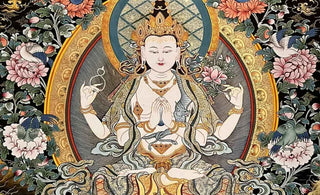
Introduction:
Thangka art, a sacred form of Buddhist painting, offers a captivating glimpse into the realm of the divine. These intricate and vibrant artworks depict various deities from Buddhist cosmology, inviting viewers to explore the profound spiritual qualities and teachings embodied by these celestial beings. In this article, we will delve into the world of Thangka portraits of deities, uncovering the symbolism, significance, and transformative power they hold.
1.The Divine in Thangka Art:
Thangka paintings serve as visual representations of the divine, capturing the essence of enlightened beings and celestial realms. The portrayal of deities in Thangka art is intended to inspire reverence, devotion, and a deep connection with the spiritual realm. Through their artistic mastery, Thangka artists bring forth the divine qualities of compassion, wisdom, and enlightenment, allowing viewers to glimpse the transcendental nature of existence.
2. Symbolism and Iconography:
Thangka portraits of deities are rich in symbolism and iconography, each element carefully chosen to convey specific spiritual qualities and teachings. The deities are often depicted with multiple arms, symbolizing their ability to engage in compassionate actions and assist sentient beings. Each hand gesture, known as a mudra, carries its own significance, representing various aspects of enlightenment and spiritual realization.
The facial expressions of the deities in Thangka art play a crucial role in conveying their enlightened nature and compassionate guidance. These serene and compassionate expressions serve as a visual representation of the divine qualities embodied by the deities and their role as compassionate guides on the path to liberation.
The serene facial expressions of the deities reflect their state of enlightenment and inner peace. They emanate a sense of tranquility and calmness, inviting viewers to experience a similar state of mind. The artists meticulously capture these expressions, using subtle brushstrokes and delicate details to convey the depth of inner peace and wisdom possessed by the deities.
Furthermore, the compassionate expressions of the deities in Thangka art convey their deep concern and care for all sentient beings. Compassion is a central virtue in Buddhism, and the deities serve as compassionate guides, offering their wisdom and guidance to those who seek spiritual liberation. The compassionate expressions on their faces remind viewers of the importance of cultivating compassion in their own lives and extending it to others.
In addition to facial expressions, the colors used in Thangka paintings also hold symbolic meaning and contribute to the overall depiction of the deities. Each color represents different qualities and energies associated with the divine. For example, the color blue often represents wisdom and the transcendental nature of the mind. It symbolizes the deep understanding and insight that the deities possess.
On the other hand, the color red is often associated with compassion and power. It represents the fiery energy of compassion that fuels the deities' actions and their ability to bring about positive change in the world. The vibrant red hues in Thangka paintings evoke a sense of warmth and vitality, emphasizing the compassionate nature of the deities.
The careful selection and use of colors in Thangka art, combined with the serene and compassionate facial expressions, create a visual language that communicates the divine qualities and teachings embodied by the deities. These artistic choices invite viewers to contemplate the significance of these qualities in their own lives and inspire them to cultivate wisdom and compassion.
3. Invoking Devotion and Connection:
Thangka portraits of deities serve as objects of devotion and focal points for spiritual practice. By gazing upon these sacred images, individuals can cultivate a deep sense of reverence and connection with the divine. The intricate details and vibrant colors of the paintings draw the viewer's attention, creating a sense of awe and wonder that inspires devotion and a longing for spiritual realization.
Devotees often engage in rituals and prayers while in the presence of Thangka portraits of deities, seeking blessings, guidance, and protection. The divine qualities embodied by the deities are believed to be accessible to practitioners, who can invoke their presence and cultivate those qualities within themselves through devotion and spiritual practice.
4. Transformative Power:
Thangka portraits of deities hold transformative power, as they act as reminders of the inherent divinity within all beings. By contemplating these sacred images, individuals are encouraged to recognize and awaken the divine qualities within themselves. The deities serve as archetypes of enlightenment, inspiring practitioners to cultivate compassion, wisdom, and other virtuous qualities in their own lives.
Through the process of engaging with Thangka portraits of deities, individuals can undergo a profound spiritual transformation. The paintings serve as mirrors, reflecting the potential for enlightenment and awakening that resides within each person. By connecting with the divine qualities represented by the deities, individuals are inspired to embark on their own spiritual journey and cultivate a deeper understanding of their true nature.
5. Beyond Religious Boundaries:
Thangka portraits of deities transcend religious boundaries, as their spiritual teachings and qualities resonate with individuals from various backgrounds and belief systems. The universal themes of compassion, wisdom, and enlightenment depicted in Thangka art have the power to touch the hearts of people seeking spiritual growth and connection, regardless of their religious affiliations.
In conclusion, Thangka portraits of deities offer a profound exploration of the divine within the realm of Buddhist art. These intricate and vibrant artworks serve as visual representations of enlightened beings, inviting viewers to connect with the transcendental qualities and teachings embodied by the deities. Through symbolism, iconography, and devotion, Thangka art inspires reverence, deepens spiritual practice, and facilitates a transformative connection with the divine. The portraits of deities in Thangka art act as mirrors, reflecting the inherent divinity within each individual and inspiring them to embark on their own journey of awakening and enlightenment.
























